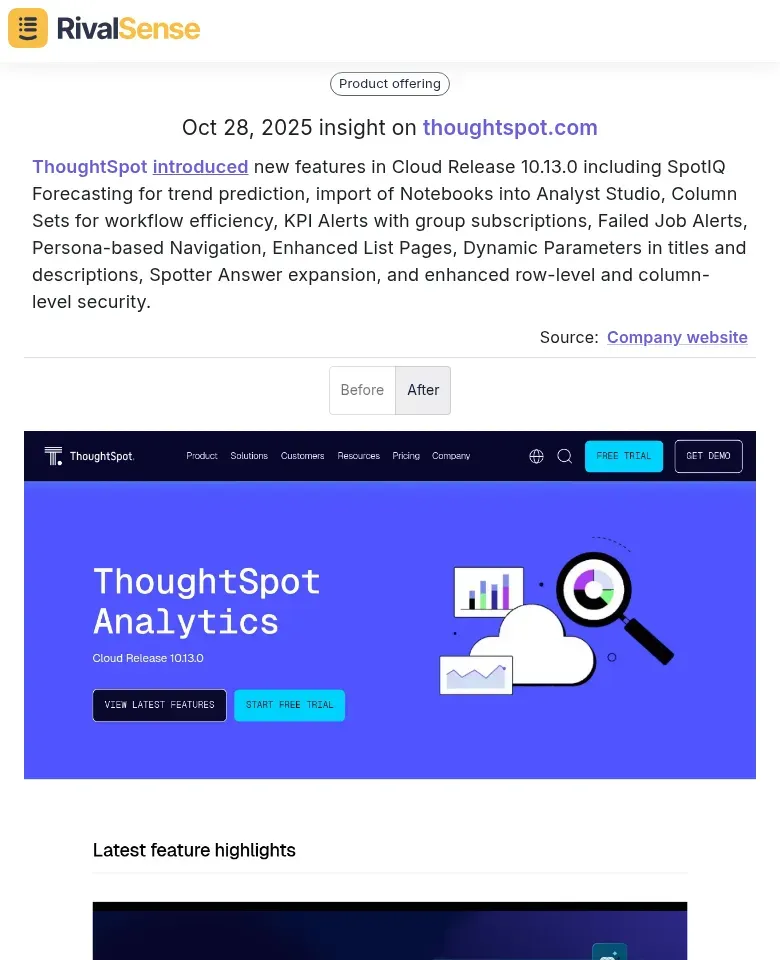Real-World Competitor Analysis: Tracking ThoughtSpot's Product Evolution
Competitor analysis is essential for staying ahead in today's fast-paced market. By monitoring rivals' moves, businesses can anticipate trends, identify opportunities, and mitigate threats effectively. This process involves systematically gathering and analyzing data on competitors' products, pricing, and strategies to inform your own decisions.
In this example, we'll explore how to apply competitor analysis using a real-world insight. We'll break down actionable steps to turn raw data into strategic advantages, helping you adapt and innovate in response to market changes.
📊 Understanding Competitor Product Launches
Keeping track of competitor product updates is a cornerstone of effective analysis. It allows you to benchmark your offerings, spot gaps in the market, and respond proactively to shifts in customer expectations. For instance, when a rival introduces new features, it can signal emerging trends or highlight areas where your own product may need enhancement.
Consider the recent update from ThoughtSpot: their Cloud Release 10.13.0 includes innovations like SpotIQ Forecasting for trend prediction, import of Notebooks into Analyst Studio, and enhanced security features. By analyzing such details, you can assess how these changes might impact user adoption or competitive positioning in the business intelligence space.

🔍 Actionable Tips for Analyzing Competitor Updates
To make competitor analysis practical, focus on extracting insights that drive immediate action. Start by categorizing updates into themes like usability, security, or innovation to prioritize your response. Then, compare these against your own roadmap to identify quick wins or necessary pivots.
Here’s a simple checklist to guide your analysis:
- ✅ Identify Key Features: Note what’s new and how it addresses customer pain points—e.g., ThoughtSpot's KPI Alerts with group subscriptions improve workflow efficiency.
- ✅ Assess Impact: Evaluate if the update could shift market share or set new industry standards, such as enhanced row-level security raising the bar for data protection.
- ✅ Plan Your Response: Decide whether to match, differentiate, or innovate beyond these features to maintain competitiveness.
Additionally, use a table to organize insights for quick reference:
| Feature Update | Potential Impact | Your Action Plan |
|---|---|---|
| SpotIQ Forecasting | May attract users needing predictive analytics | Explore adding similar AI-driven tools |
| Persona-based Navigation | Improves user experience for diverse roles | Review your UI for persona customization |
| Dynamic Parameters | Enhances report flexibility | Assess integration into your analytics suite |
🚀 Leveraging Tools for Continuous Monitoring
Manual tracking of competitors can be time-consuming and prone to oversight. Automating this process with specialized tools ensures you never miss critical updates, from pricing changes to partnership announcements. This approach frees up resources for deeper analysis and strategic planning.
For example, RivalSense aggregates data from websites, social media, and registries to deliver regular reports on product launches, media mentions, and more. By using such insights, you can stay informed without constant manual checks, enabling faster decision-making.
Ready to streamline your competitor analysis? Try out RivalSense for free at https://rivalsense.co/ to get actionable insights like the ThoughtSpot example, and receive your first report today to start optimizing your strategy!
📚 Read more
👉 How to Track and Benchmark Competitor Customer Satisfaction: A Strategic Guide
👉 Optimize Smart Building Integration with Key Account Tracking Apps
👉 How Talent Movement Insights Transformed Competitive Strategy Against inDrive
👉 LinkedIn Competitive Analysis: Unlock Key Account Growth Insights
👉 Mapping Competitor Moves: Transport Industry Productivity Tactics
